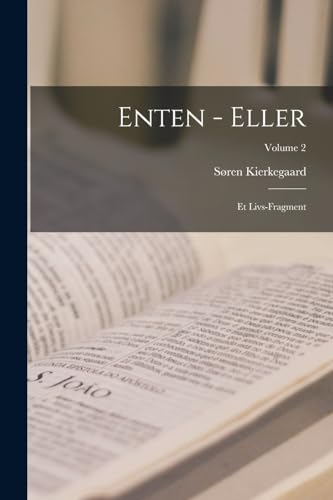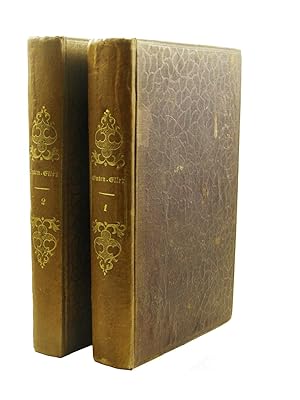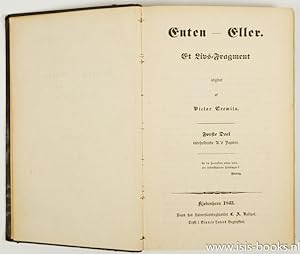Enten Eller Et Livs Fragment, Used (10 results)
FeedbackSearch filters
Product Type
- All Product Types
- Books (10)
- Magazines & Periodicals (No further results match this refinement)
- Comics (No further results match this refinement)
- Sheet Music (No further results match this refinement)
- Art, Prints & Posters (No further results match this refinement)
- Photographs (No further results match this refinement)
- Maps (No further results match this refinement)
- Manuscripts & Paper Collectibles (No further results match this refinement)
Condition Learn more
Binding
Collectible Attributes
- First Edition (2)
- Signed (No further results match this refinement)
- Dust Jacket (No further results match this refinement)
- Seller-Supplied Images (3)
- Not Print on Demand (10)
Language (2)
Price
- Any Price
- Under US$ 25 (No further results match this refinement)
- US$ 25 to US$ 50
- Over US$ 50
Free Shipping
Seller Location
Seller Rating
-
Enten - Eller: Et Livs-Fragment; Volume 2 -Language: danish
Seller: GreatBookPrices, Columbia, MD, U.S.A.
US$ 28.62
Convert currencyUS$ 2.64 shipping within U.S.A.Quantity: Over 20 available
Add to basketCondition: As New. Unread book in perfect condition.
-
Enten - Eller: Et Livs-Fragment; Volume 1 -Language: danish
Seller: GreatBookPrices, Columbia, MD, U.S.A.
US$ 28.93
Convert currencyUS$ 2.64 shipping within U.S.A.Quantity: Over 20 available
Add to basketCondition: As New. Unread book in perfect condition.
-
Enten - Eller: Et Livs-Fragment; Volume 1 -Language: danish
Seller: GreatBookPrices, Columbia, MD, U.S.A.
US$ 44.65
Convert currencyUS$ 2.64 shipping within U.S.A.Quantity: Over 20 available
Add to basketCondition: As New. Unread book in perfect condition.
-
Enten - Eller: Et Livs-Fragment; Volume 1 -Language: danish
Seller: GreatBookPricesUK, Woodford Green, United Kingdom
US$ 31.41
Convert currencyUS$ 19.81 shipping from United Kingdom to U.S.A.Quantity: Over 20 available
Add to basketCondition: As New. Unread book in perfect condition.
-
Enten - Eller: Et Livs-Fragment; Volume 2 -Language: danish
Seller: GreatBookPricesUK, Woodford Green, United Kingdom
US$ 32.80
Convert currencyUS$ 19.81 shipping from United Kingdom to U.S.A.Quantity: Over 20 available
Add to basketCondition: As New. Unread book in perfect condition.
-
Enten-eller et livs-fragment. Forste deel + anden deel
Published by Kopenhagen, Hagerup's Forlag 1950, 1950
Seller: Antiquarian Bookshop Klikspaan, Leiden, Netherlands
US$ 52.94
Convert currencyUS$ 22.05 shipping from Netherlands to U.S.A.Quantity: 1 available
Add to basket2 volumes. - 417 + 363 pages. - Softcover, unopened.
-
Enten - Eller: Et Livs-Fragment; Volume 1 -Language: danish
Seller: GreatBookPricesUK, Woodford Green, United Kingdom
US$ 47.37
Convert currencyUS$ 19.81 shipping from United Kingdom to U.S.A.Quantity: Over 20 available
Add to basketCondition: As New. Unread book in perfect condition.
-
Enten-Eller: Et Livs-Fragment (Either/Or: A Fragment)
Published by C. A. Reitzel, Copenhagen, 1843
Seller: Burnside Rare Books, ABAA, Portland, OR, U.S.A.
First Edition
Condition: Very Good. First Edition. First edition of Soren Kierkegaard's best-known work, Either/Or. Octavo. Two volumes bound in contemporary half-calf over marbled boards; bound without the half-titles. Text in Danish. Very Good rubbing and wear to bindings, neatly rebacked with old spines preserved. Former owner names to preliminary blacks and owner's rubber stamp to title pages. Contents tanned, sporadically foxed and occasionally lightly stained. A lovely set. Either/Or, Danish philosopher Søren Aabye Kierkegaard's groundbreaking first published work. Only 525 copies of this edition were published in 1843 under an editorial pseudonym ("Victor Emerita") at the author's own expense. It was mostly written during his stay in Berlin, where he took notes on Schelling's Philosophy of Revelation. It includes essays of literary and music criticism and a set of romantic-like-aphorisms, as part of his larger theme of examining the reflective and philosophical structure of faith. He is widely considered to be the first existentialist philosopher. "As a thinker, Kierkegaard had to wait for the twentieth century to find his audience; he is now generally considered to be, however eccentric, one of the most important Christian philosophers," write Carter and Muir in Printing and the Mind of Man.
-
Enten-Eller Et Livs-Fragment. udgivet af Victor Eremita (Either-Or, A Fragment of Life).
Published by C.A. Reitzel, Kjøbenhavn, 1843
First Edition
FIRST EDITION. Kierkegaard's Famous "Either-Or" Challenge to Life - PMM 314Volume 1: Half-title + TP + [V]-XX = Forord + [XXI] = Indhold + half-title + [3]-470 + 2 blank leaves; Volume 2: Half-title + TP + 1 leaf = Inhold + half-title + [1]-368 + 1 blank leaf, Octavo, First Edition (Himmelstrup 20).With the often missing half-titles present. This is one of only 525 copies printed of this work."Kierkegaard's third published book and the first of many pseudonymous 'aesthetic' works. Generally regarded as the first major statement of his own unsystematic philosophy, this 'fragment' is a literary and philosophical tour de force incorporating a stunning array of subject matter, literary effects, and moods, including melancholy aphorisms and personal meditation, elaborate musical, dramatic and literary criticism, lyrical effusions, odd essays on unhappiness and boredom, a strange 'Seducer's Diary' and, in the second volume, an extended treatise on marriage, the human personality and the ethical life in the form of a letter from a Judge to a younger man, capped by a sermon sounding a note of radical doubt about both the aesthetic and ethical justifications for existence." (Wronoski, p. 11)"Enten-Eller was written before he was twenty-nine. It is a curious bundle of papers, essays, semi-dialogues and notes, seemingly ill-assorted, but in fact dialectically arranged. Adopting what he called an 'aesthetic attitude' he held that this consisted in balancing possibilities, and that in matters religious and ethical it was up to the individual to make his choice. Choice, as the title of his work suggests, was at the root of Kierkegaard's theory. There can be no system of existence, only a system of ideas. From this he develops his thesis of 'Existence" (since taken up by the modern Existentialist), in which human beings considered as subjects not objects are the only real existence: their reflective as opposed to active nature being focused on the 'acts' of making perpetual decisions" (PMM, pp. 190-91) Printing and the Mind of Man 314. Contemporary embossed cloth with gilt decorations and lettering on the spines (which have been lightened by the sun). The half title volume one has the author's real name handwritten beneath the pseudonym (Victor Cremita) and someone has tried unsuccessfully to eradicate this - leaving the name and a small dark cloud around it. This failed attempt has bled over to the title page which shows a small cloudy stain in the corresponding location. (See photos.) The title page of volume 2 has a small, faded purple circular stamp (with no lettering) in the lower right corner. Other than these noted imperfections, this is a really lovely copy of this important work in Western Philosophy. ADDITIONAL PHOTOS AVAILABLE UPON REQUEST.
-
US$ 1,764.75
Convert currencyUS$ 28.56 shipping from Netherlands to U.S.A.Quantity: 1 available
Add to basketCopenhagen, Universitetsboghandler C.A. Reitzel, 1843. (XX), (2), 470 pp. Hardcover with marbled textblock. *Joint weak on both sides, spine damaged, edges rubbed, paper slightly browned, some watermarks and other stains, some pencilmarks, owner's name, otherwise good condition* Without the second volume. 'Kierkegaard (1813-1855) was a Danish philosopher who is considered to be the father of modern existentialism. Either-or is the first book published by Kierkegaard under a pseudonym, the personage Victor Eremita. In Either-Or, Kierkegaard describes two modes of existence, the aesthetical and the ethical, encouraging his reader to proceed from the first to the second mode. According to Kierkegaard, the ordinary man in daily life exists aesthetically. However, there is a hierarchy between different stages of existence: from the aesthetic one can proceed to the ethical and, finally, to the religious mode. (The religious mode is discussed explicitly in other works such as Fear and Trembling, Philosophical Fragments, and Concluding Unscientific Postscripts). In Either-Or Kierkegaard opposes the aesthetical and the ethical mode of existence by personifying them: an individual called ?A? represents the aesthetical, whereas the ethical is represented by the personage of a judge. Reading Either-Or, one follows the exchange of letters between the two figures whereby the judge critically reflects and discusses the problematic aspects of A?s aesthetic life. Aspects such as personal satisfaction, the chase of fleeting pleasures, the ignorance of consequences and the emphasis on the immediacy of experience are characteristic of the aesthetic mode of existence. Instead of being guided by immediacy, the ethical mode of existence is guided by reflection and a strong will, directing the individual to an improved self (seen in an ethical light).?








